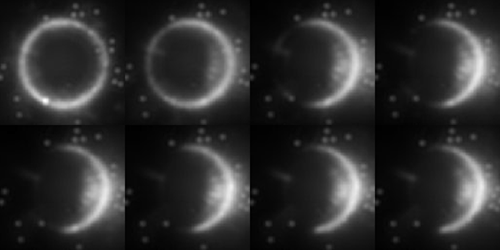Mapping the Thermal Forces That Push Particles through Liquids
Particles dispersed in a liquid typically jitter aimlessly in response to the random buffeting they receive from the molecules that surround them. But if the liquid is subjected to a steep temperature gradient, this random motion can become directional as the temperature gradient sets up flows that move the particles from hot regions of the liquid to colder ones. The theory of this so-called thermophoresis is actively developing, but direct observations of both the suspended particles and the liquid molecules are scant. Now Tetsuro Tsuji of Kyoto University in Japan and his colleagues have experimentally characterized the tiny surface flows that drive thermophoresis [1]. Those flows could be harnessed to move and concentrate DNA and other large biomolecules that are suspended in liquids.
For their experiments, the team glued a single polystyrene sphere, 7 µm in diameter, to the lid of a tiny transparent box. They filled the box with water laced with 500-nm-diameter fluorescent tracers. Shining a laser up through the bottom of the box, the team repeatedly drew a circle around the sphere, a process that trapped tracers located within the circle of light. The team focused a second laser, tuned to one of water’s absorption bands, at a spot 18 µm from the polystyrene sphere, locally heating the water to create a temperature gradient in the liquid and across the sphere.
Using a microscope the team observed that, after a few seconds, the tracers started flowing over the sphere’s surface, moving from the sphere’s cold end to its warmer one. From the observations, the researchers showed that this flow imparted momentum to the sphere. They also inferred the force that would have propelled the sphere away had it not been immobilized. Modeling the system under different conditions confirmed the inferences.
–Charles Day
Charles Day is a Senior Editor for Physics Magazine.
References
- T. Tsuji et al., “Thermo-osmotic slip flows around a thermophoretic microparticle characterized by optical trapping of tracers,” Phys. Rev. Appl. 20, 054061 (2023).




